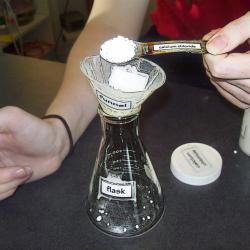Source Institutions
Source Institutions
Add to list Go to activity
Activity link broken? See if it's at the internet archive

In this activity, learners explore temperature changes from chemical reactions by mixing urea with water in one flask and mixing calcium chloride with water in another flask. They observe that the urea flask gets cold and the calcium chloride flask gets hot. The main idea is that some chemical processes release heat energy and are exothermic, while some chemical processes absorb heat energy and are endothermic. This activity is currently used in the Nature of Matter Unit in OMSI's Chemistry Lab. Cost estimates are per 100 learners.
- 5 to 10 minutes
- Under 5 minutes
- $1 - $5 per group of students
- Ages 4 - adult
- Activity, Experiment/Lab Activity
- English
Quick Guide
Materials List (per group of students)
- (2) 250-mL erlenmeyer flasks
- (2) 1-tsp measuring spoons
- (2) small plastic funnels
- 25-mL graduated cylinder
- 1kg calcium chloride pellets (CaCl2-anhydrous)
- 1kg urea (NH2CONH2)
- 250-mL squeeze bottle
- (2) small jars with lids
Subjects
-
Physical Sciences
-
Heat and Thermodynamics
- Heat and Temperature
- Heat Transfer
-
Chemistry
- Solutions
-
Heat and Thermodynamics
Audience
To use this activity, learners need to:
- see
- read
- touch
Learning styles supported:
- Involves hands-on or lab activities
Other
This resource is part of:
Access Rights:
- Free access
By:
Rights:
- All rights reserved, Oregon Museum of Science and Industry, 1997
Funding Source:
- National Science Foundation, 9355628
